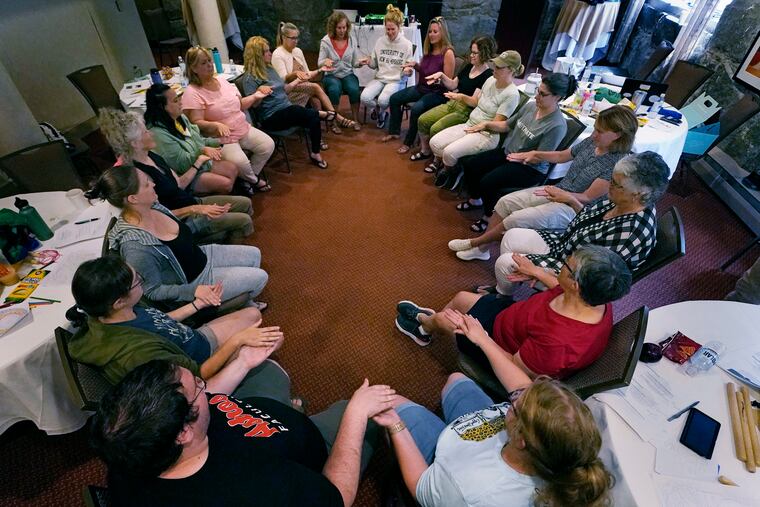To attract and retain teachers, we must address the underlying causes of burnout
A new series of recruiting plans do nothing to address the root causes of burnout among educators.

Recently, one of my students pointed out matter-of-factly that she couldn’t be a teacher. “I’d snap,” she continued. I just smiled. What else could I do?
The student certainly didn’t know how many Brené Brown books were sitting on my Audible shelf, or how every bathroom break had become a practice in the Serenity Prayer. As an urban educator in Philadelphia, I have learned to smile at comments like “you are doing the Lord’s work” or “you must be an angel” at networking events — I can’t help but think to myself: Surely, the Lords anointed in every religion have received rest.
As an advocate for issues of teacher well-being, I was struck when the Pennsylvania Department of Education released a plan to recruit new teachers into the profession. Recently, state teacher certification fell by 70% from 20,000 in 2012 to just 6,000. While Laura Boyce of Teach Plus Pennsylvania, a proponent of the legislation, remarked, “Pennsylvania’s educators pour their hearts into helping our most precious resource, our children … It’s time to elevate teachers, the most important resource profession in our society, to the level of appreciation and prestige that they deserve,” the state plan misses systemic issues on teacher attrition and dismisses educators who have been doing the hard work.
The plan is a slap in the face to education professionals who have worked tirelessly, often for decades, to educate the commonwealth’s children. The plan focuses on ways of onboarding new professionals to the state of Pennsylvania, including expediting the certification process, certificate reciprocity for out-of-state teachers, attracting a diverse workplace, and creating pathways (albeit, vague ones) for growth and development opportunities.
However, the policy does nothing to address the plight of current teachers, especially from low-income districts like my own in Philadelphia. The measures do nothing to address the retention of such employees by examining policies that have led to burnout and, ultimately, attrition. To attract and retain teachers, we must address the underlying causes of burnout in the profession.
Burnout is not a new phenomenon for many of the state’s educators. It can have emotional components, like emotional exhaustion and memory loss, or physical manifestations, like fatigue, insomnia, and hypertension. It is also correlated with depression and anxiety, which have a host of secondary issues.
Countless news stories have reported the need for substitutes, the growing need for mental health resources, and professional burnout following pandemic stressors. But for educators who have worked in the forgotten classrooms of large urban centers like Philadelphia, these conditions, and feelings of continued stress and burnout, are nothing new.
Our stories are just a reflection of policymaking and a public unconsciousness that has supported apartheid of education and a legacy of burnout in the profession. Eliminating teacher burnout begins with addressing the systemic flaws of our education system: funding inequities and orientations to teacher well-being.
“Eliminating teacher burnout begins with addressing the systemic flaws of our education system.”
The inequity of funding largely frames the environmental conditions that have greatly contributed to the burnout of educators in the city. The gap has largely created the $4.5 billion in deferred maintenance in the district, which was highlighted in The Inquirer’s investigation “Toxic City” in 2016. An ongoing lawsuit in Pennsylvania, William Penn School District et al. v. Pennsylvania Department of Education et al., highlights the disparity in resourcing that has been created in the state. The Education Law Center points out, “Low-wealth Pennsylvania school districts have $4,800 less to spend per pupil than wealthy school districts — and this gap, one of the widest in the country, is growing.”
Aside from building conditions, this inadequate resourcing has long prevented educators from accessing the resources they need to successfully do their jobs. In the absence of school climate managers, counselors, and mental health professionals, teachers volunteer to fill these roles and provide support.
It is important to note that many of our colleagues in affluent and well-resourced districts are experiencing an exponential increase in resource-related stress for the first time. Local periodicals are replete with stories about teacher shortages, climate issues, early retirements, and juggling responsibilities. With time, these will even out — surely, well-resourced districts will have teachers return, but for many teachers, pandemic woes are just the tipping point of career burnout.
Lydia Kulina-Washburn is a high school English language arts teacher at the School District of Philadelphia. @LydiaKulina